Analysis of the Effect of an Open Hole on the Buckling of a Compressed Composite Plate
Abstract
:1. Introduction
2. The Subject of Study
3. Methodology
4. Experimental Study
- a1, a2—unknown parameters of the function,
- P—load,
- Pcr—critical load,
- u—shortening of the plate corresponding to the critical load.
5. FEM Analysis
- [K]—structural stiffness matrix,
- [H]—stress stiffness matrix,
- λi—i-th eigenvalue,
- ψ—i-th eigenvector of displacement.
6. Discussion of the Results
- δ—relative error,
- FEM—numerical results,
- EXP—experimental values.
| S_Ø0 mm | S_Ø2 mm | S_Ø4 mm | S_Ø8 mm | |||
|---|---|---|---|---|---|---|
| S1 [45|−45|90|0]s | FEM | [N] | 199 | 198 | 194 | 179 |
| EXP | [N] | 187 | 182 | 178 | 163 | |
| relative error | [%] | 6.03% | 8.08% | 8.25% | 8.94% | |
| S2 [0|−45|45|90]s | FEM | [N] | 649 | 644 | 628 | 573 |
| EXP | [N] | 610 | 585 | 572 | 524 | |
| relative error | [%] | 6.01% | 9.02% | 8.92% | 8.55% | |
| S3 [0|90|0|90]s | FEM | [N] | 694 | 685 | 667 | 601 |
| EXP | [N] | 639 | 628 | 619 | 553 | |
| relative error | [%] | 7.93% | 8.32% | 7.20% | 7.99% | |
7. Conclusions
- The study of the effect of the hole of the compressed plate in the critical state showed high agreement between the proposed test methods. No clear effect of the hole size on the form of buckling of the plate was observed. In all cases, one local half-wave was formed.
- On the other hand, a clear effect of the hole on the value of the critical load was determined. The maximum decrease in the value of the critical load equal to 14% was obtained for the plate with the S2 fiber layout, while the minimum decrease was 13% for the S1 plate. At the same time, the relative error between the numerical and experimental values of the critical load was no more than 9%.
- The post-critical work paths for the real plate and the FEM model show similar stability. This confirms the validity of the plate model developed in the numerical analysis, which made it possible to realize the issue of non-linear stability. For all analyzed plates, a change in the stiffness of the post-critical characteristic was observed with an increase in the size of the hole. The maximum decrease in the stiffness of the post-critical characteristic equal to 14% was obtained for the plate with the S1 layout, and the minimum equal to 10% was obtained for the plate with the layout S3.
- The study showed the effect of the layout of the fibers on the behavior of the compressed hole plates. It was observed that the S1 plate with composite layout [45|−45|90|0]s had more than three times lower strength compared to S2 [0|−45|45|90]s and S3 [0|90|0|90]s. This is evidenced by the displacement of the stiffest layer with the [0] layup to the plane of symmetry, thus weakening the S1 plate.
- The results of the critical and post-critical state analysis show the assumed trend. Numerical analysis was characterized by higher values compared to experimental ones. This is evidenced by the fact that the numerical analysis compared to the experiment represents ideal test conditions. At the same time, the satisfactory quantitative agreement of the results of the numerical analysis with the experimental results confirms the adequacy of the developed numerical model, which in the simulated case reproduces the behavior of the real plate with a hole.
Funding
Institutional Review Board Statement
Informed Consent Statement
Data Availability Statement
Conflicts of Interest
Correction Statement
References
- Kopecki, T.; Lis, T.; Mazurek, P. Post-critical deformation of thin-walled load-bearing aircraft structure representing fragment of the one-way torsion box. Adv. Sci. Technol. Res. J. 2018, 12, 203–209. [Google Scholar] [CrossRef]
- Campbell, F.C. Manufacturing Technology for Aerospace Structural Materials, 1st ed.; Elsevier: Amsterdam, The Netherlands; Boston, MA, USA, 2006. [Google Scholar]
- Stewart, R. Rebounding automotive industry welcome news for FRP. Reinf. Plast. 2011, 55, 38–44. [Google Scholar] [CrossRef]
- Bambach, M.R. Fibre composite strengthening of thin-walled steel vehicle crush tubes for frontal collision energy absorption. Thin-Walled Struct. 2013, 66, 15–22. [Google Scholar] [CrossRef]
- Timoshenko, S.; Gere, J.M. Theory of Elastic Stability, 2nd ed.; Dover Publications: Mineola, NY, USA, 2009. [Google Scholar]
- Jayashankarbabu, B.S.; Karisiddappa. Stability of Square Plate with Concentric Cutout. Int. J. Civ. Environ. Eng. 2014, 8, 259–267. [Google Scholar] [CrossRef]
- Bazant, Z.P.; Cedolin, L.; World Scientific (Firm). Stability of Structures: Elastic, Inelastic, Fracture and Damage Theories; World Scientific Pub. Co.: Singapore; Hackensack, NJ, USA, 2010. [Google Scholar]
- Banat, D.; Mania, R.J. Comparison of failure criteria application for FML column buckling strength analysis. Compos. Struct. 2016, 140, 806–815. [Google Scholar] [CrossRef]
- Teter, A.; Debski, H.; Samborski, S. On buckling collapse and failure analysis of thin-walled composite lipped-channel columns subjected to uniaxial compression. Thin-Walled Struct. 2014, 85, 324–331. [Google Scholar] [CrossRef]
- Banat, D.; Kolakowski, Z.; Mania, R.J. Investigations of fml profile buckling and post-buckling behaviour under axial compression. Thin-Walled Struct. 2016, 107, 335–344. [Google Scholar] [CrossRef]
- Ascione, F. Influence of initial geometric imperfections in the lateral buckling problem of thin walled pultruded GFRP I-profiles. Compos. Struct. 2014, 112, 85–99. [Google Scholar] [CrossRef]
- Czapski, P.; Jakubczak, P.; Lunt, A.J.G.; Kaźmierczyk, F.; Urbaniak, M.; Kubiak, T. Numerical and experimental studies of the influence of curing and residual stresses on buckling in thin-walled, CFRP square-section profiles. Compos. Struct. 2021, 275, 114411. [Google Scholar] [CrossRef]
- Wysmulski, P. The effect of load eccentricity on the compressed CFRP Z-shaped columns in the weak post-critical state. Compos. Struct. 2022, 301, 116184. [Google Scholar] [CrossRef]
- Różyło, P. Experimental-numerical test of opensection composite columns stabilitysubjected to axial compression. Arch. Mater. Sci. Eng. 2017, 84, 58–64. [Google Scholar] [CrossRef]
- Wysmulski, P.; Debski, H.; Falkowicz, K. Sensitivity of Compressed Composite Channel Columns to Eccentric Loading. Materials 2022, 15, 6938. [Google Scholar] [CrossRef]
- Yang, S.W.; Hao, Y.X.; Zhang, W.; Yang, L.; Liu, L.T. Free vibration and buckling of eccentric rotating FG-GPLRC cylindrical shell using first-order shear deformation theory. Compos. Struct. 2021, 263, 113728. [Google Scholar] [CrossRef]
- Turvey, G.J.; Zhang, Y. A computational and experimental analysis of the buckling, postbuckling and initial failure of pultruded GRP columns. Comput. Struct. 2006, 84, 1527–1537. [Google Scholar] [CrossRef]
- Cheng, B.; Zhao, J. Strengthening of perforated plates under uniaxial compression: Buckling analysis. Thin-Walled Struct. 2010, 48, 905–914. [Google Scholar] [CrossRef]
- Różyło, P.; Dębski, H.; Kral, J. Buckling and limit states of composite profiles with top-hat channel section subjected to axial compression. In AIP Conference Proceedings; AIP Publishing: Lublin, Poland, 2018; p. 080001. [Google Scholar] [CrossRef]
- Duarte, A.P.C.; Díaz Sáez, A.; Silvestre, N. Comparative study between XFEM and Hashin damage criterion applied to failure of composites. Thin-Walled Struct. 2017, 115, 277–288. [Google Scholar] [CrossRef]
- Motamedi, D.; Mohammadi, S. Fracture analysis of composites by time independent moving-crack orthotropic XFEM. Int. J. Mech. Sci. 2012, 54, 20–37. [Google Scholar] [CrossRef]
- Kalita, K.; Shinde, D.; Haldar, S. Analysis on Transverse Bending of Rectangular Plate. Mater. Today Proc. 2015, 2, 2146–2154. [Google Scholar] [CrossRef]
- Pan, Z.; Cheng, Y.; Liu, J. Stress analysis of a finite plate with a rectangular hole subjected to uniaxial tension using modified stress functions. Int. J. Mech. Sci. 2013, 75, 265–277. [Google Scholar] [CrossRef]
- Bau, H.; Hoyt, D.; Rousseau, C. Open Hole Compression Strength and Failure Characterization in Carbon/Epoxy Tape Laminates. In Composite Structures: Theory and Practice; Grant, P., Rousseau, C., Eds.; ASTM International: West Conshohocken, PA, USA, 2001; p. 273. [Google Scholar] [CrossRef]
- Verri, F.R.; Junior, J.F.S.; de Faria Almeida, D.A.; de Oliveira, G.B.B.; de Souza Batista, V.E.; Honório, H.M.; Noritomi, P.Y.; Pellizzer, E.P. Biomechanical influence of crown-to-implant ratio on stress distribution over internal hexagon short implant: 3-D finite element analysis with statistical test. J. Biomech. 2015, 48, 138–145. [Google Scholar] [CrossRef] [PubMed]
- Guan, W.; Zhu, Y.; Wang, W.; Wang, F.; Zhang, J.; Wu, Y.; Zheng, Z. Experimental and numerical buckling analysis of carbon fiber composite cylindrical shells under external pressure. Ocean. Eng. 2023, 275, 114134. [Google Scholar] [CrossRef]
- Falkowicz, K.; Valvo, P. Influence of Composite Lay-Up on the Stability of Channel-Section Profiles Weakened by Cut-Outs—A Numerical Investigation. Adv. Sci. Technol. Res. J. 2023, 17, 108–115. [Google Scholar] [CrossRef]
- Cerik, B.C. Ultimate strength of locally damaged steel stiffened cylinders under axial compression. Thin-Walled Struct. 2015, 95, 138–151. [Google Scholar] [CrossRef]
- Storozhuk, E.A.; Maksimyuk, V.A.; Chernyshenko, I.S. Nonlinear Elastic State of a Composite Cylindrical Shell with a Rectangular Hole. Int. Appl. Mech. 2019, 55, 504–514. [Google Scholar] [CrossRef]
- Daliri, O.S.; Farahani, M. Characterization of Stress Concentration in Thin Cylindrical Shells with Rectangular Cutout Under Axial Pressure. Int. J. Adv. Des. Manuf. Technol. 2017, 10, 133–141. [Google Scholar]
- Prabu, B.; Raviprakash, A.V.; Venkatraman, A. Parametric study on buckling behaviour of dented short carbon steel cylindrical shell subjected to uniform axial compression. Thin-Walled Struct. 2010, 48, 639–649. [Google Scholar] [CrossRef]
- Rathinam, N.; Prabu, B. Numerical study on influence of dent parameters on critical buckling pressure of thin cylindrical shell subjected to uniform lateral pressure. Thin-Walled Struct. 2015, 88, 1–15. [Google Scholar] [CrossRef]
- Lo Frano, R.; Forasassi, G. Experimental evidence of imperfection influence on the buckling of thin cylindrical shell under uniform external pressure. Nucl. Eng. Des. 2009, 239, 193–200. [Google Scholar] [CrossRef]
- Wang, W.; Zhu, Y.; Zhou, L.; Zhang, J. Buckling characteristics of carbon fiber composite/aluminium alloy combined cylindrical shells under external hydrostatic pressure. Int. J. Press. Vessel. Pip. 2024, 208, 105125. [Google Scholar] [CrossRef]
- Higuchi, R.; Warabi, S.; Yoshimura, A.; Nagashima, T.; Yokozeki, T.; Okabe, T. Experimental and numerical study on progressive damage and failure in composite laminates during open-hole compression tests. Compos. Part A Appl. Sci. Manuf. 2021, 145, 106300. [Google Scholar] [CrossRef]
- Camanho, P.P.; Maimí, P.; Dávila, C.G. Prediction of size effects in notched laminates using continuum damage mechanics. Compos. Sci. Technol. 2007, 67, 2715–2727. [Google Scholar] [CrossRef]
- Higuchi, R.; Okabe, T.; Nagashima, T. Numerical simulation of progressive damage and failure in composite laminates using XFEM/CZM coupled approach. Compos. Part A Appl. Sci. Manuf. 2017, 95, 197–207. [Google Scholar] [CrossRef]
- Wang, C.; Nagashima, T. Damage propagation analysis of CFRP laminate by quasi-3D XFEM using hexahedral elements. Compos. Struct. 2023, 316, 117024. [Google Scholar] [CrossRef]
- Jonak, J.; Karpinski, R.; Wojcik, A.; Siegmund, M. The Effect of Undercut Anchor Diameter on the Rock Failure Cone Area in Pullout Tests. ASTR J. 2022, 16, 261–270. [Google Scholar] [CrossRef]
- Grzejda, R.; Warzecha, M.; Urbanowicz, K. Determination of the Preload of Bolts for Structural Health Monitoring of a Multi-Bolted Joint: FEM Approach. Lubricants 2022, 10, 75. [Google Scholar] [CrossRef]
- Nozdrzykowski, K.; Grządziel, Z.; Grzejda, R.; Warzecha, M.; Stępień, M. An Analysis of Reaction Forces in Crankshaft Support Systems. Lubricants 2022, 10, 151. [Google Scholar] [CrossRef]
- Jonak, J.; Karpiński, R.; Wójcik, A. Numerical analysis of undercut anchor effect on rock. J. Phys. Conf. Ser. 2021, 2130, 012011. [Google Scholar] [CrossRef]
- Jonak, J.; Karpiński, R.; Wójcik, A. Numerical analysis of the effect of embedment depth on the geometry of the cone failure. J. Phys. Conf. Ser. 2021, 2130, 012012. [Google Scholar] [CrossRef]
- Grzejda, R.; Parus, A.; Kwiatkowski, K. Experimental Studies of an Asymmetric Multi-Bolted Connection under Monotonic Loads. Materials 2021, 14, 2353. [Google Scholar] [CrossRef]
- IOP Publishing Ltd. Preface. J. Phys. Conf. Ser. 2023, 2676, 011001. [Google Scholar] [CrossRef]
- Falkowicz, K. Experimental and numerical failure analysis of thin-walled composite plates using progressive failure analysis. Compos. Struct. 2023, 305, 116474. [Google Scholar] [CrossRef]
- Li, W.; Cai, H.; Li, C.; Wang, K.; Fang, L. Progressive failure of laminated composites with a hole under compressive loading based on micro-mechanics. Adv. Compos. Mater. 2014, 23, 477–490. [Google Scholar] [CrossRef]
- Wysmulski, P.; Falkowicz, K.; Filipek, P. Buckling state analysis of compressed composite plates with cut-out. Compos. Struct. 2021, 274, 114345. [Google Scholar] [CrossRef]
- El-Sawy, K.M.; Ikbal Martini, M. Elastic stability of bi-axially loaded rectangular plates with a single circular hole. Thin-Walled Struct. 2007, 45, 122–133. [Google Scholar] [CrossRef]
- Falkowicz, K. Validation of Extension-Bending and Extension-Twisting Coupled Laminates in Elastic Element. Adv. Sci. Technol. Res. J. 2023, 17, 309–319. [Google Scholar] [CrossRef]
- Wysmulski, P. Load Eccentricity of Compressed Composite Z-Columns in Non-Linear State. Materials 2022, 15, 7631. [Google Scholar] [CrossRef] [PubMed]
- Wysmulski, P. Numerical and Experimental Study of Crack Propagation in the Tensile Composite Plate with the Open Hole. Adv. Sci. Technol. Res. J. 2023, 17, 249–261. [Google Scholar] [CrossRef] [PubMed]
- Wysmulski, P. Failure Mechanism of Tensile CFRP Composite Plates with Variable Hole Diameter. Materials 2023, 16, 4714. [Google Scholar] [CrossRef] [PubMed]
- Paszkiewicz, M.; Kubiak, T. Selected problems concerning determination of the buckling load of channel section beams and columns. Thin-Walled Struct. 2015, 93, 112–121. [Google Scholar] [CrossRef]
- Falkowicz, K.; Wysmulski, P.; Debski, H. Buckling Analysis of Laminated Plates with Asymmetric Layup by Approximation Method. Materials 2023, 16, 4948. [Google Scholar] [CrossRef]
- Wysmulski, P.; Debski, H. The analysis of sensitivity to eccentric load of compressed thin-walled laminate columns. In AIP Conference Proceedings; AIP Publishing: Depok, Indonesia, 2019; p. 020006. [Google Scholar] [CrossRef]
- Abaqus HTML Documentation. 2016.
- Wysmulski, P.; Teter, A.; Debski, H. Effect of load eccentricity on the buckling of thin-walled laminated C-columns. In AIP Conference Proceedings; AIP Publishing: Lublin, Poland, 2018; p. 080008. [Google Scholar] [CrossRef]
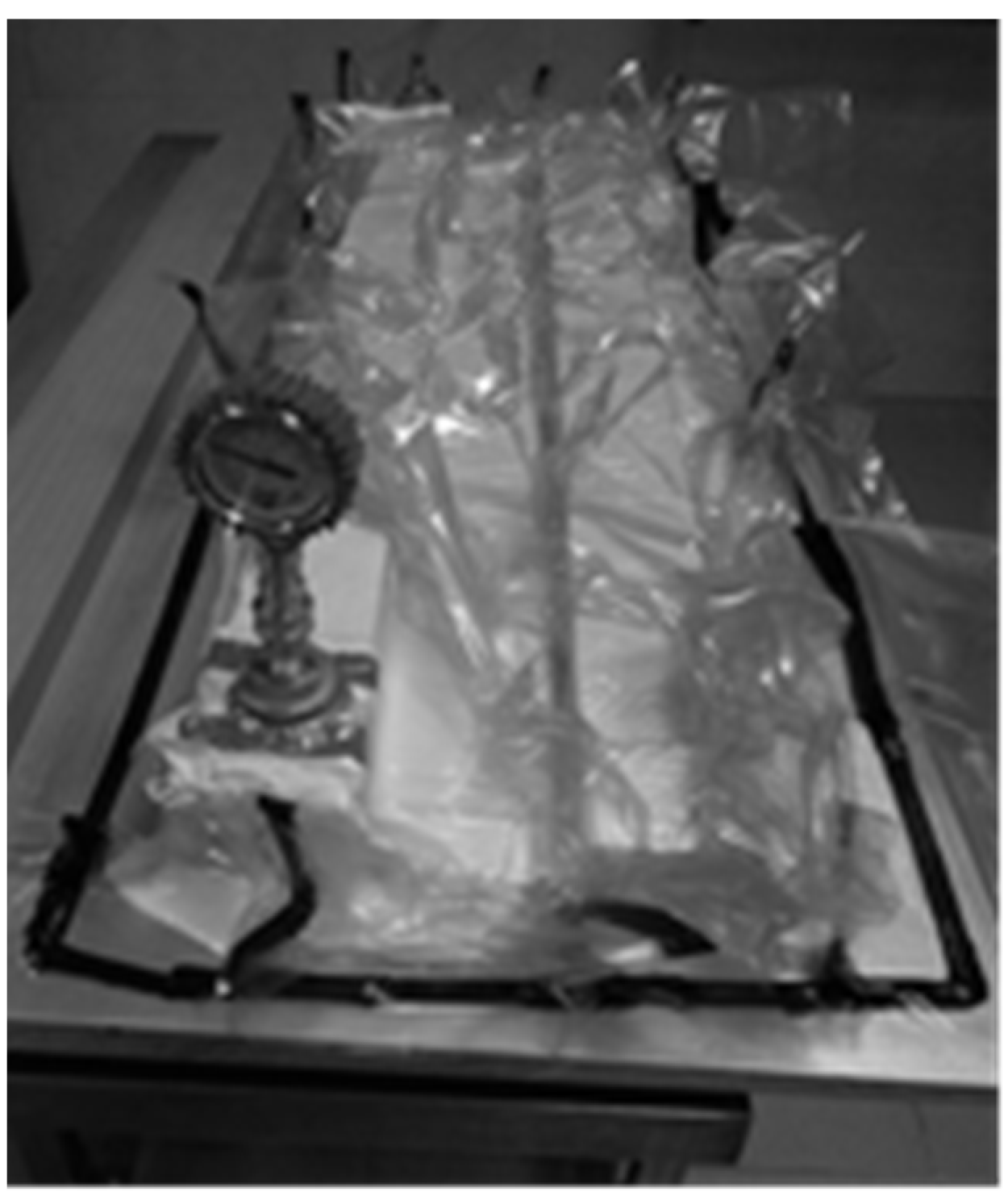



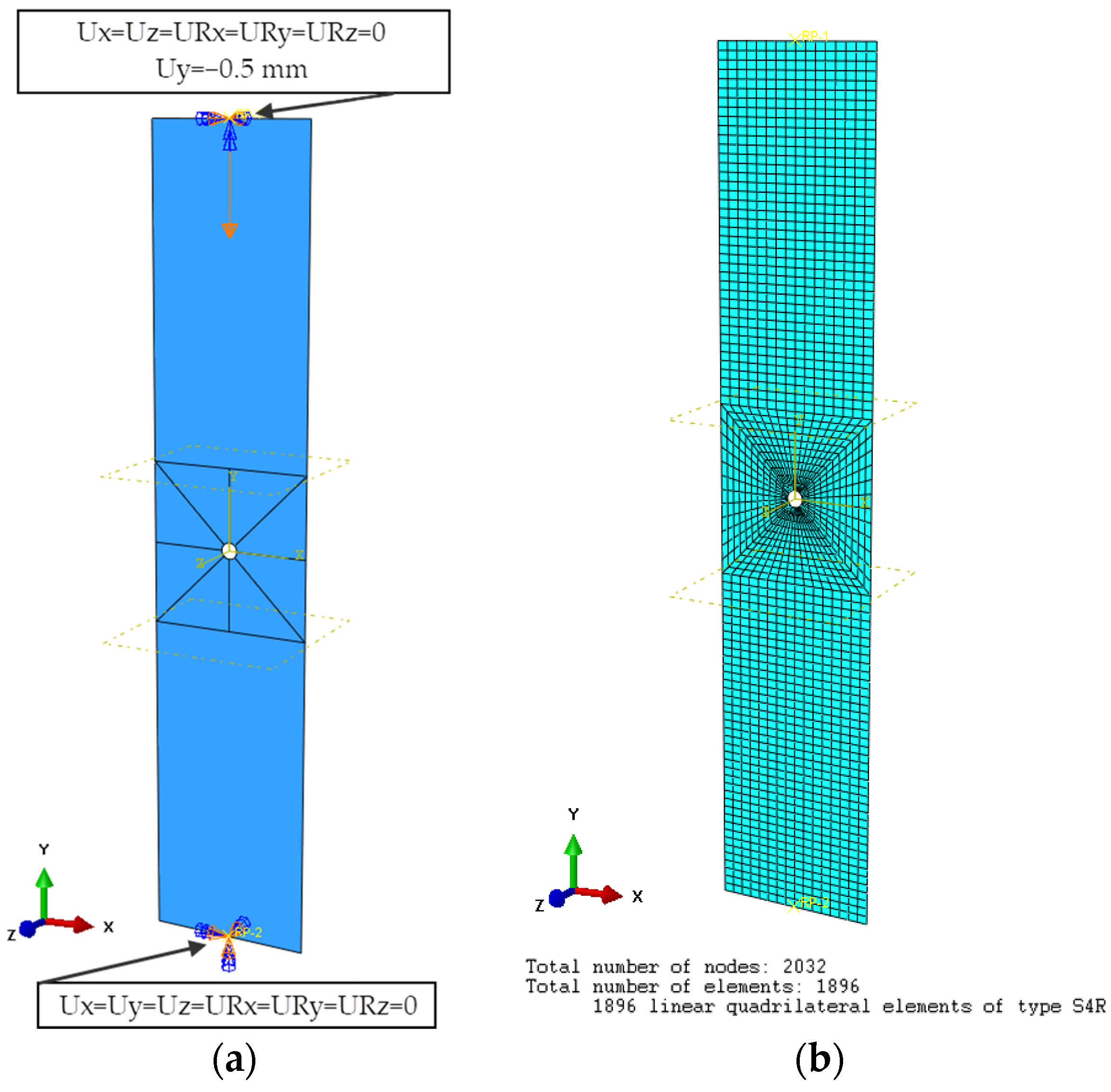

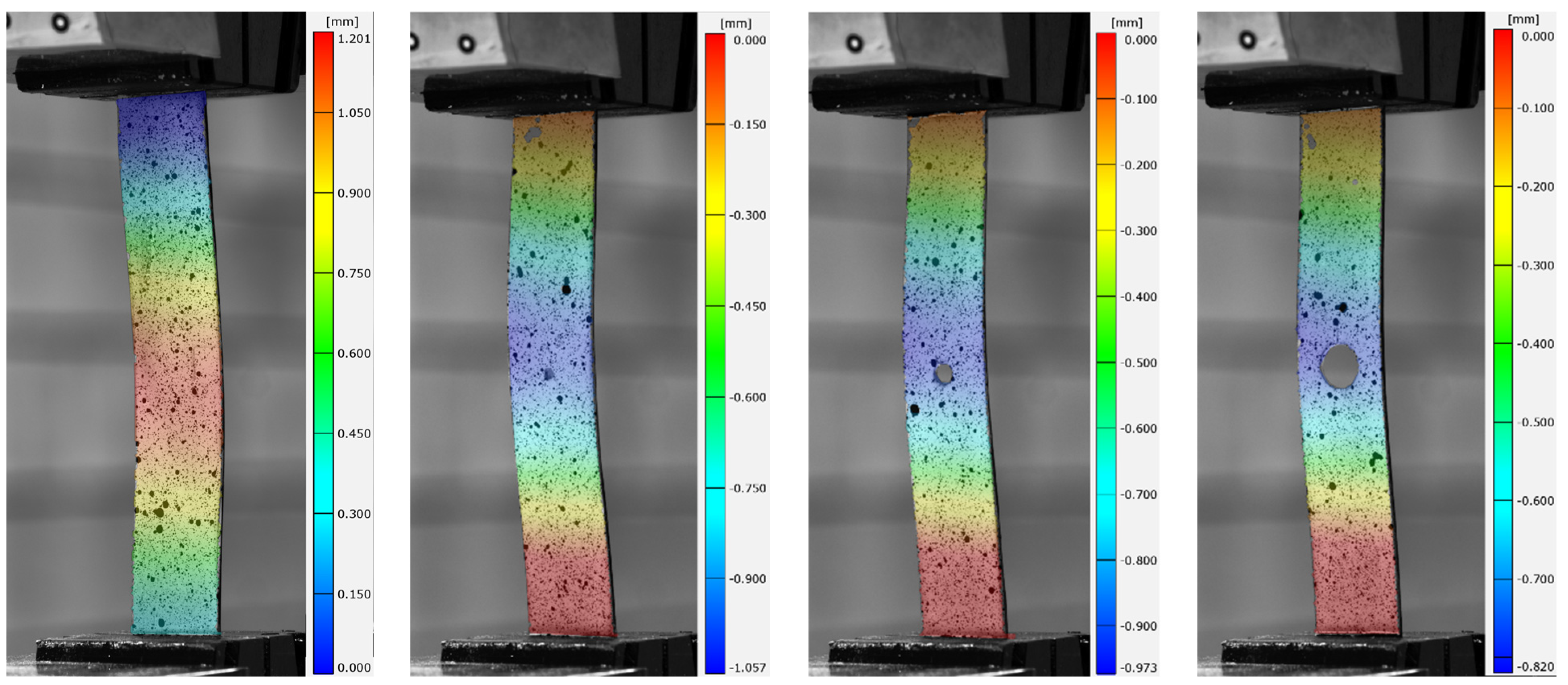

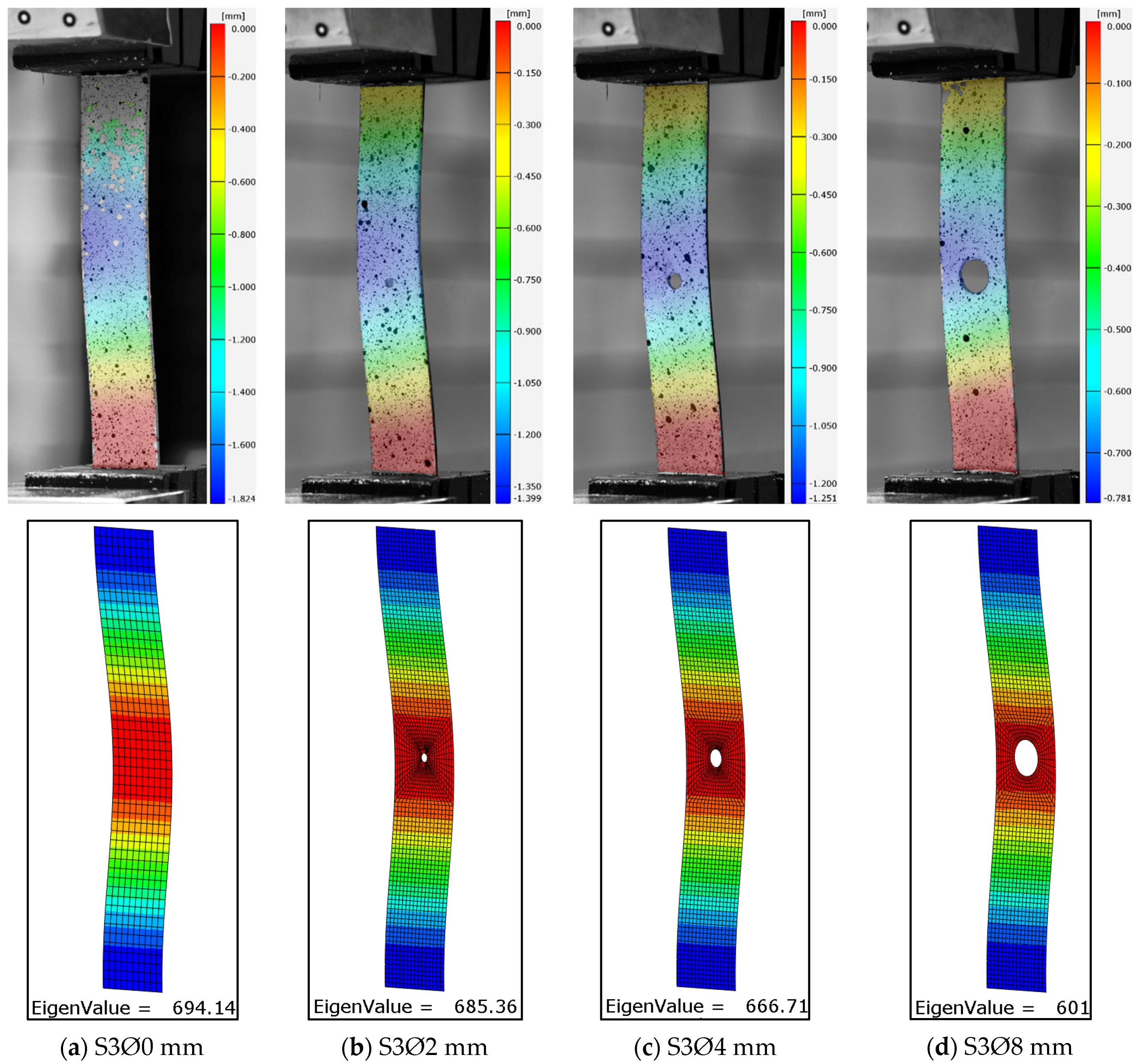
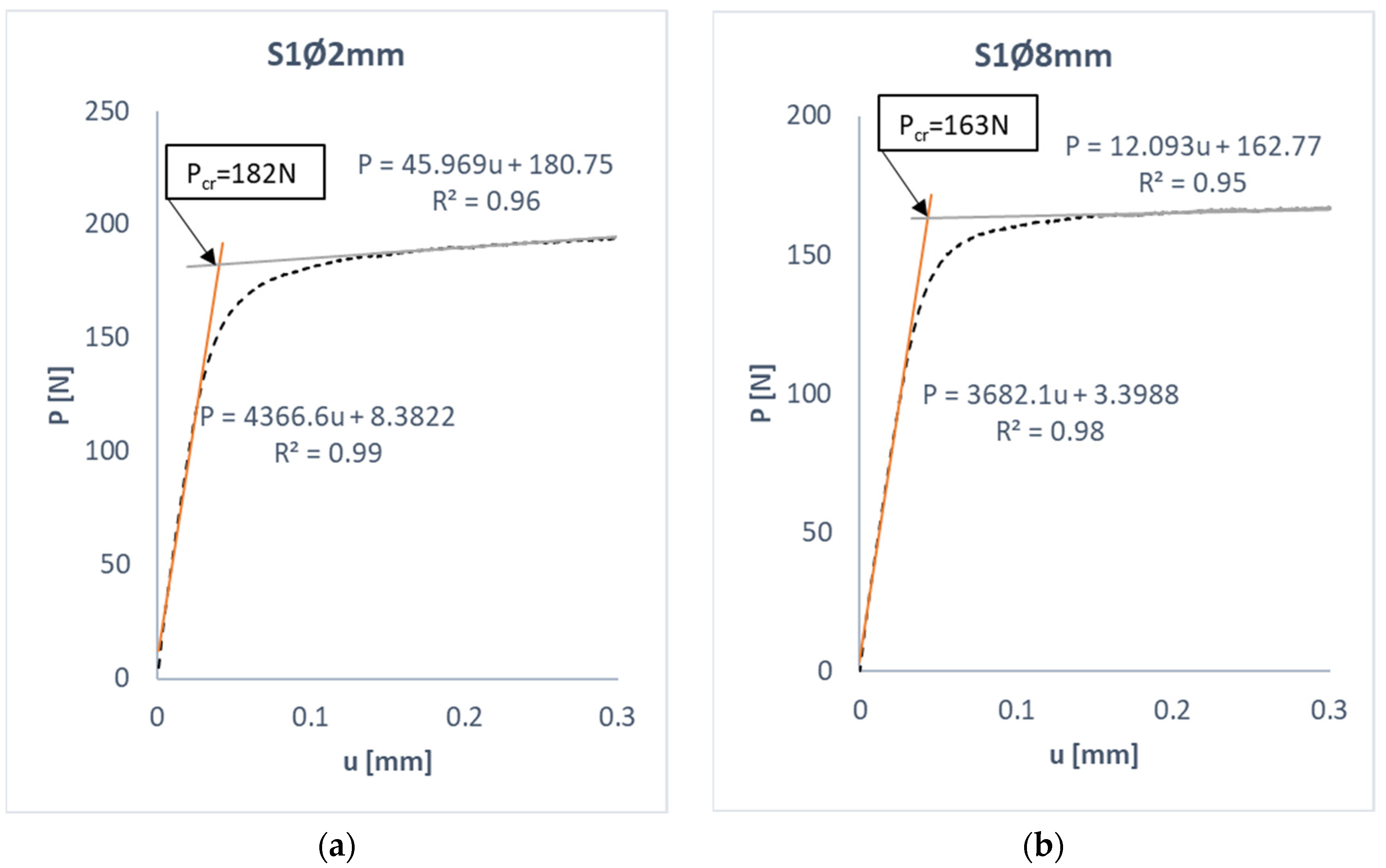


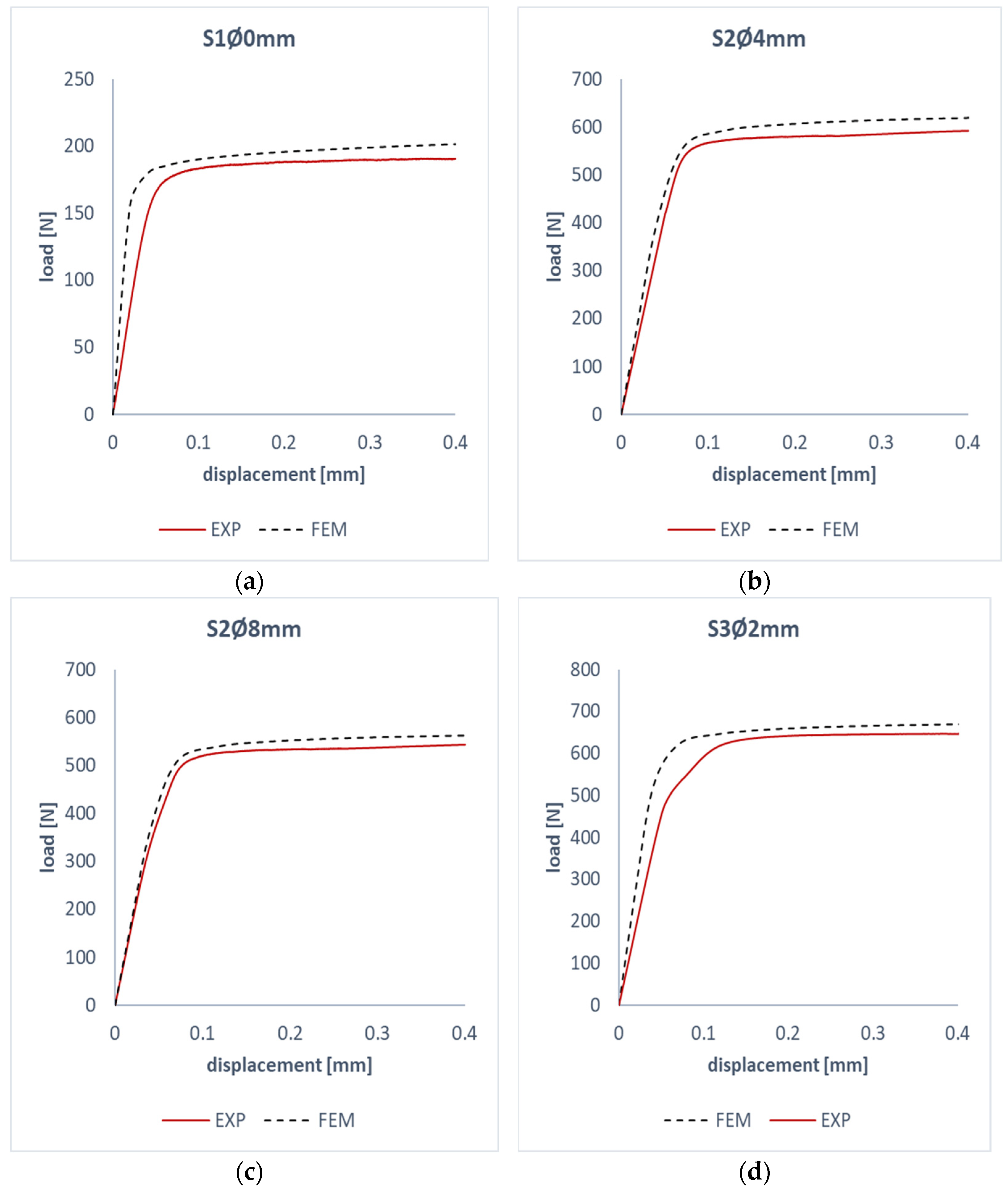

| Sample | Laminate Layout |
|---|---|
| S1 | [45|−45|90|0|0|90|−45|45]T |
| S2 | [0|−45|45|90|90|45|−45|0]T |
| S3 | [0|90|0|90|90|0|90|0]T |
| Tensile Strength | FTU | 0° | 1867 MPa |
| 90° | 26 MPa | ||
| Tensile Modulus | E1 | 0° | 131.71 GPa |
| E2 | 90° | 6.36 GPa | |
| Poisson’s Ratio | ν12 | 0° | 0.32 |
| Shear Strength | FSU | ±45° | 100.15 MPa |
| Shear Modulus | G12 | ±45° | 4.18 GPa |
| Compression Strength | FCU | 0° | 1531 MPa |
| 90° | 214 MPa |
Disclaimer/Publisher’s Note: The statements, opinions and data contained in all publications are solely those of the individual author(s) and contributor(s) and not of MDPI and/or the editor(s). MDPI and/or the editor(s) disclaim responsibility for any injury to people or property resulting from any ideas, methods, instructions or products referred to in the content. |
© 2024 by the author. Licensee MDPI, Basel, Switzerland. This article is an open access article distributed under the terms and conditions of the Creative Commons Attribution (CC BY) license (https://creativecommons.org/licenses/by/4.0/).
Share and Cite
Wysmulski, P. Analysis of the Effect of an Open Hole on the Buckling of a Compressed Composite Plate. Materials 2024, 17, 1081. https://doi.org/10.3390/ma17051081
Wysmulski P. Analysis of the Effect of an Open Hole on the Buckling of a Compressed Composite Plate. Materials. 2024; 17(5):1081. https://doi.org/10.3390/ma17051081
Chicago/Turabian StyleWysmulski, Pawel. 2024. "Analysis of the Effect of an Open Hole on the Buckling of a Compressed Composite Plate" Materials 17, no. 5: 1081. https://doi.org/10.3390/ma17051081





